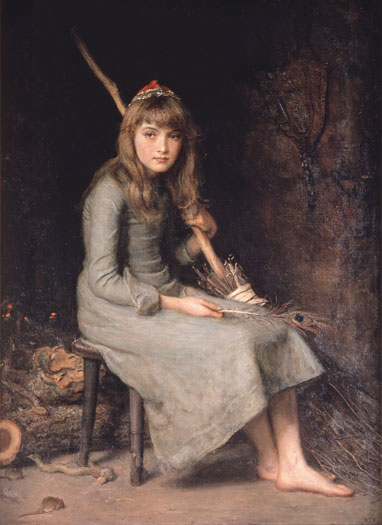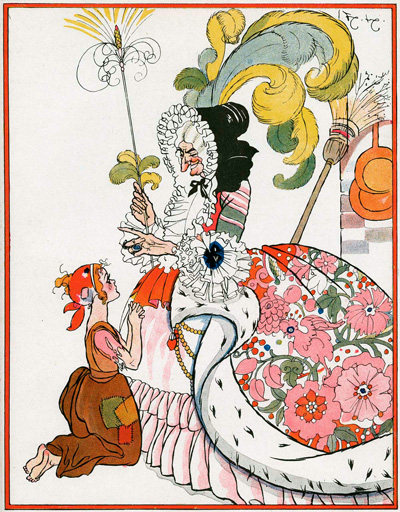I'll be posting lots of Cinderella-themed posts in the near future, as I've started going through the book Cinderella: A Casebook. This is one of my all-time favorite books on fairy tales; it's full of essays on Cinderella which all take different approaches and is very helpful in getting an overall feel for the tale's history and meanings, without just reading into one person's personal interpretations. Someone needs to make a Beauty and the Beast: A Casebook.
Cinderella's history is very long and complicated, but as far as European history goes, Giambattista Basile's Cat Cinderella is one of the first recorded versions.
The heroine's name is Zezolla. Her father, a Prince, doted on her completely, but remarried a harsh woman who hated Zezolla. But the girl had a governess who loved her, and Zezolla wished her governess could be her mother instead. So the governess instructed her to murder her stepmother (by asking for a dress kept in a large chest, and slamming the lid on her head while it was looking in the chest) and then persuade her father to marry her governess. Zezolla does this, and for a few days her new stepmother is kind towards her, but later forgot Zezolla's kindness towards her and became cruel again. She also brought out six daughters of her own she had kept hidden, and they all forced Zezolla to do the work, calling her "Cat Cinderella." This element of having two separate stepmothers seems odd, as they fulfill the same function in the story, and the reader is less inclined to sympathise with Zezolla, as she partially brings her struggles on herself, and is a murderer. Nevertheless, the story continues:
A dove flew to Zezolla after the marriage of her father to the governess and told her, "If you ever desire anything, send to ask for it from the dove of the fairies of the Island of Sardinia, and you will at once have it." The Prince shortly had to go to Sardinia on a trip, and offered to bring presents home for his daughters. The stepdaughters all asked for clothes, cosmetics, games, and the like, but Zezolla asked for the dove of the fairies to bring her something. Her father continued on the trip, remembering all the presents but his own daughter's. When it came time to leave, his vessel would not leave the harbor. The captain was told in a dream that because the Prince broke a promise to his daughter, that is why the ship would not leave. Once he told the Prince this, he hastened to fulfill his daughter's wish.
This strikes me because it is similar to a very common motif in most Animal Bridegroom/Beauty and the Beast tales: the father goes on a trip and asks his daughters which presents they would like. The elder/evil sisters ask for material goods, and Beauty asks for a rose-part of nature. Zezolla's gift, as we will see, ends up being from nature as well.
By the way, once I uploaded this picture I realized it's not appropriate to this post because Basile's story doesn't have a fairy godmother. So, this is the part in the story that will later have a fairy godmother in it, when Perrault gets around to it. But in this version (and the Grimm's,) we have a magical tree instead. So, the fairies' gift to Zezolla was a date tree, and all the things necessary to cultivate it. Zezolla was overjoyed with her gift, and planted the tree, which grew to the size of a woman in four days. A fairy steps out and asks Zezolla what she wants. She says she wanted to get away from the house without her sisters knowing. The fairy told Zezolla a spell she could use to be robed in beautiful clothes, thus serving as her disguise.
On a feast day, Zezolla ran to the tree and got her magical outift and hurried after her sisters, who did not recognize her. The King happened to see her and was enchanted. He ordered a trusted servant to follow her, but Zezolla cleverly threw coins on the grounds, and the servant was too tempted by the money. The King was later angry at the servant and made him promise he would follow the girl next time.
However, the next time Zezolla cast down pearls and jewels. The King was now furious with his servant, and he was the one to be clever the third time-he fastened himself to the carriage with thread. When Zezolla saw he wasn't being distracted, in her agitation she lost her patten, or shoe covering. (Note the absence of the time restriction or the significance of midnight.) The servant brought this to the King, who spouts out a little ode that begins with this: "If the foundation is so fair, what must be the mansion? Oh, lovely candlestick which holds the candle that consumes me! Oh, tripod of the lovely cauldron in which my life is boiling!" and goes on with ever more ridiculous metaphors.
So the King threw a feast for all the women in the land. After eating, he went around and tried the shoe on every foot, but it fit no one. So the King had another feast for the next day, and ordered that no woman be left at home. The Prince admitted he had a daughter, but that she was a "sorry, worthless creature, not fir to take her place at the table where you eat." The King's response: "Let her be at the top of the list, for such is my wish."
When Zezolla entered the next day, the King thought he recognized her, but said nothing. Note that, because Cinderella critics often point out that the Prince (who's a King here) is a)shallow, and b)stupid because he can't recognize Cinderella's face, only counts on her being alone in her shoe size. Stupidity especially applies to the Grimms' Prince, who starts riding away with both stepsisters, thinking they are Cinderella, and has to be told by birds that their shoes are leaking blood. So at least in Basile's world, though the King might have fallen in love at first sight, he still recognizes Zezolla in her rags, and the shoe is more like a confirmation. In fact, the shoe "darted forward of itself to shoe that painted Lover's egg, as the iron flies to the magnet." Zezolla becomes Queen and the stepmother and sisters are duly humiliated.




Great post. This is such an interesting version of the tale. I produce a podcast on fairy tales called Tabled Fables and I just spoke to a cultural history professor who told me the version of Cat Cinderella by Giambattista Basile. You can have a listen on the blog: http://tabledfables.tumblr.com/
ReplyDeleteAnd the entire Cinderella podcast will be posted this Wednesday at soundcloud.com/tabledfables
Hi I would like to ask you why you think the writer would make Zezollas character kill her stepmother because like you said its harder to sympathize with her. There must be a reason why the writer did this. :)
ReplyDeleteI don't know enough about Basile to guess at his intentions; I think what makes it complex is that Zezolla was instructed by an adult to murder, and she's been mistreated by her stepmother (although the text only says that the stepmother makes faces at her, so maybe Zezolla is just being a drama queen??). If she had come up with the plan on her own she would seem evil, but she is being manipulated by the governess. Maybe Basile was trying to show that murder is never a good option because you might end up right back where you started? Whoever tells you to kill someone is probably someone you don't want as your stepmother anyway
Deletei gotta ask is the prince/king zezollas father if so does that mean she married her own father to be king
ReplyDeleteIt’s my opinion Fairytales are not by their very nature, perhaps by genre, logical, rationale or even reasonable stories. In fact the less they explain, justify or sense realistically they make the more Faire and thus “magical” they are. Inside every listener or reader exists all the characters of any story not only the heroine, hero, the protagonist. We all whether we like to admit it or not have had such intense emotions if we look plainly enough can empathize with a murderous cinderella or a jealous, or greedy, calculating villain such as the step mother(#1 or #2). We are all the characters in our subconscious where we are always working out who we are. I propose and enjoy the fairy tale that is not fully explainable, justifiable or even sensical. Non-sense is part of the magical, a gateway, a portal to the other side of consciousness or our personal shadow. Needing to clean and tidy up the loose ends of fairy tales by us all agreeing on their definition may put their allure, power and healing properties out of reach for us. Yet in time they will be rediscovered and rescued from all the sanitizing, mass-marketing and exploitation for kings, courts and corporations.
ReplyDelete